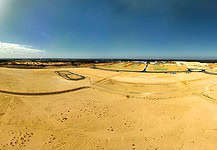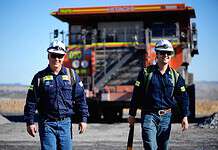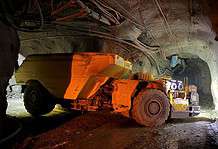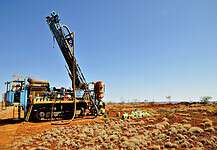Newmont’s Boddington operation in WA. All images: Newmont.
BY ELIZABETH FABRI
ALL signs indicate Newmont Mining could dethrone Barrick Gold as the world’s largest gold producer this year. Newmont’s Australian division has been a key player in the race, kicking goals across its three operations – KCGM, Tanami, and Boddington.
Back in 2007, Newmont’s vice-chairman at the time, Pierre Lassonde, told reporters at the Kalgoorlie Diggers and Dealers conference that he hoped Newmont would overtake Barrick Gold (its joint venture partner in KCGM) in the gold space.
In 2016, Newmont president and chief executive Gary Goldberg told Bloomberg this wasn’t an area of focus; instead the value that is added to projects and growing margins.
“We’re not about getting bigger, it’s about growing margins,” Mr Goldberg said.
However, by looking at the two gold major’s production outlooks for 2018 Barrick may not stay in the lead for much longer.
Now, the gap between the two miners’ production guidance was particularly narrow, with Newmont and Barrick producing 5.30 million ounces and 5.32moz of gold in 2017 respectively.
This year, Newmont set a guidance of between 4.9 and 5.4moz, while Barrick expects full-year gold production of between 4.5 and 5.0moz.
In the first quarter of the 2018 calendar year, Newmont produced 1.21moz of gold, with no change to the company’s full year guidance, while Barrick Gold production sat at 1.05moz.
“Newmont delivered solid operating and financial results in the first quarter,” Mr Goldberg said.
The performance, however, was overshadowed by a tragic accident in April at its Ahafo Mill Expansion in Ghana, which resulted in six fatalities.
“Production has recommenced at Ahafo and Akyem but civil construction at the Ahafo Mill Expansion project will remain suspended until we and the authorities are satisfied that work can resume safely,” Mr Goldberg said.
“In the meantime, our priorities are to support the people who lost loved ones in the accident and cooperate with authorities to investigate its causes.”

Boddington in Focus
In Australia, the Newmont team has been busy launching its first centralised process control hub, which allows experts at each site to collaborate in resolving problems and raising performance.
Newmont said this year it aimed to produce between 1.5 and 1.7moz from its Australian division, and between 1.4 and 1.6moz in 2019 and 2020; this equates to roughly 17 per cent of the country’s total production.
The slight slump in the coming years can be attributed to a stripping campaign at Boddington to access higher grade ore, which will be completed in 2020, just in time to offset lower grade stockpiles at KCGM.
Boddington, within the Saddleback greenstone belt of WA 130km southeast of Perth, is currently Australia’s largest gold mine producing 787,000oz in 2017 (KCGM is soon tipped to overtake the mine).
It operates two pits utilising three electric rope shovels as its prime ex-pit material movers, with a fleet of 40 production haul trucks, and a fleet of ancillary equipment.
It is also one of the biggest private employers in the South West region, recruiting close to 2000 people, with deep ties in the community through initiatives such as the Moorditj Booja Community Partnership Agreement and its Kalyagool Kadadjiny Scholarship – worth $120,000 – to Murdoch indigenous students who want to pursue a career in mining.
In an April conference call, Newmont chief operating officer Tom Palmer said the company was currently optimising Boddington’s mill maintenance strategy to reduce the number of plant shutdowns per year from four to three.
“This change delayed some production in the first quarter but we expect to recover those ounces over the course of the year,” Mr Palmer said.
“Mine sequencing at Boddington resulted in higher copper and lower gold production in Q1.
“We expect to reach higher gold grades during the second quarter and remain on track to achieve our full year targets.”
Outlook
If Newmont and Barrick stick to their production guidance – Newmont could become the world’s largest gold producer by the end of the year.
Mr Goldberg said this year was the first time since the global financial crisis that he had seen signs of economic recovery and growth in developed and emerging markets.
“These conditions – coupled with decreasing mine supply and increasing demand for gold as a safe haven – create a brighter outlook for gold and for Newmont,” he said.
In the first quarter, the company achieved higher than expected profits due to higher average realised gold prices.
“We expect to deliver steady gold production at competitive costs over the next five years and beyond,” Mr Goldberg said.
“This will give us the means to continue investing in the next generation of Newmont mines and leaders.”























































